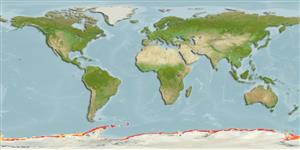Symplectoscyphus naumovi Blanco, 1969
| Native range | All suitable habitat | Point map | Year 2050 |

|
| This map was computer-generated and has not yet been reviewed. |
| Symplectoscyphus naumovi AquaMaps Data sources: GBIF OBIS |
Upload your photos
Google image |
No photo available for this species.No drawings available for Sertulariidae.
Google image |
No photo available for this species.
Classification / Names Common names | Synonyms | CoL | ITIS | WoRMS
Hydrozoa | Leptothecata | Sertulariidae
Environment: milieu / climate zone / depth range / distribution range Ecology
Sessile; depth range 0 - 640 m (Ref. 7416). Polar
Distribution Countries | FAO areas | Ecosystems | Occurrences | Introductions
Circum-Antarctic.
Length at first maturity / Size / Weight / Age
Maturity: Lm ? range ? - ? cm Max length : 2.5 cm H male/unsexed; (Ref. 7416)
Short description Morphology
Colonies composed of stolonal hydrorhiza giving rise to monosiphonic stems up to 2.5 cm high. Stems unbranched or scarcely branched; branches without anastomoses. Hydrothecate internodes long and thin, usually longer than hydrothecal length. Hydrotheca placed on distal third or quarter of internode. Hydrothecae alternately arranged in one plane, large and tubular. Adcauline hydrothecal wall adnate for approximately one-third of its length. Free part of adcauline hydrothecal wall straight or slightly convex. Abcauline hydrothecal wall straight or slightly concave. Cusps of hydrothecal aperture sharp and separated by deep embayments. Occasionally with hydrothecal renovations. Gonothecae ovoid, with short distal neck; walls smooth or slightly wavy, with indistinct striae.
Length based on colonies height.
Life cycle and mating behavior Maturity | Reproduction | Spawning | Eggs | Fecundity | Larvae
Found with gonothecae in February and March; materials were collected in January and February.
Main reference
References | Coordinator | Collaborators
Peña Cantero, A.L., A. Svoboda and W. Vervoort. 2002. (Ref. 7416)
IUCN Red List Status (Ref. 130435: Version 2024-1)
CITES status (Ref. 108899)
Not Evaluated
CMS (Ref. 116361)
Not Evaluated
Threat to humans
Harmless
Human uses
| FishSource |
Tools
More information
Trophic Ecology
Food items
Diet
Food consumption
Ration
Predators
Diet
Food consumption
Ration
Predators
Ecology
Population dynamics
Growth
Age/Size
Length-weight
Length-length
Length-frequencies
Mass conversion
Recruitment
Abundance
Age/Size
Length-weight
Length-length
Length-frequencies
Mass conversion
Recruitment
Abundance
Life cycle
Distribution
Human Related
Aquaculture profile
Stamps, Coins Misc.
Stamps, Coins Misc.
Outreach
Taxonomy
References
Internet sources
BHL | BOLD Systems | CISTI | DiscoverLife | FAO(Publication : search) | Fishipedia | GenBank (genome, nucleotide) | GloBI | Gomexsi | Google Books | Google Scholar | Google | PubMed | Tree of Life | Wikipedia (Go, Search) | Zoological Record
Estimates based on models
Preferred temperature
(Ref. 115969): -1.8 - 0.9, mean -1 (based on 311 cells).


